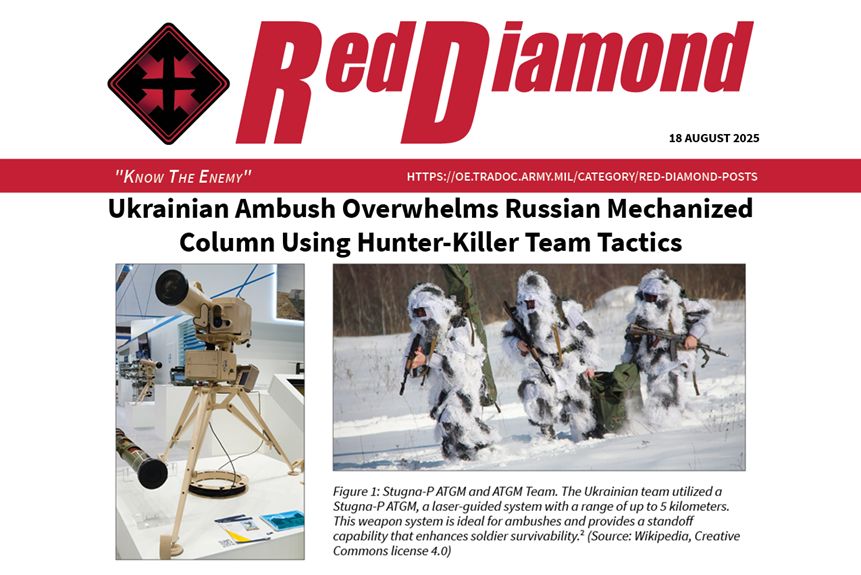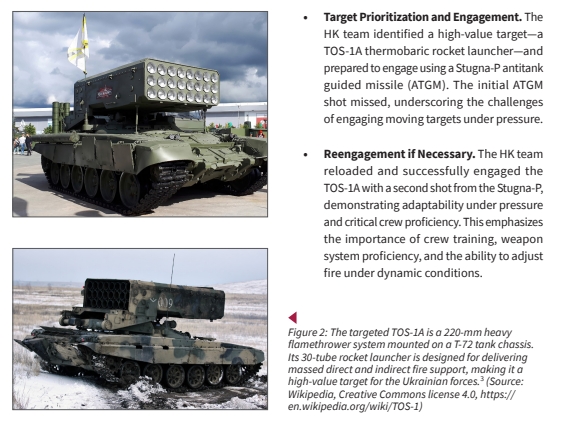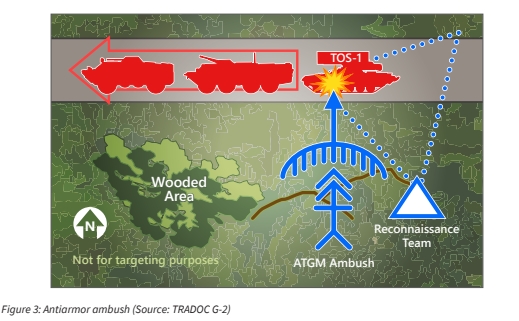
Ukrainian Ambush Overwhelms Russian Mechanized Column Using Hunter-Killer Team Tactics
By Kristin Lechowicz
Ukrainian ambushes using hunter-killer (HK) team tactics are demonstrating success in large-scale
combat operations (LSCO) against a technologically superior force, providing actionable lessons for
U.S. Army small-unit training. While drones’ rapid evolution and Russia’s attrition strategy have played
significant roles in the Russia-Ukraine conflict, ambush dynamics also play a significant role. In March
2022, a Ukrainian reconnaissance element ambushed a Russian mechanized column, and the attack was
captured on video.1
• Reconnaissance and Target Selection. The Ukrainian HK team positioned itself in a concealed
location, observed the Russian convoy, and exercised disciplined target discrimination, allowing
less valuable targets to pass while maintaining communication with other elements. Successful
ambush operations rely on quality reconnaissance and inter-unit coordination to support precise
target discrimination. This approach ensures that limited resources flow toward high-impact
engagements while allowing the team to remain concealed and avoid premature detection.



The Ukrainian attack exemplifies the “waiting ambush,” outlined in Chinese and Russian military
doctrine.4 This approach, leveraging terrain, patience, and disciplined target selection, aligns with
People’s Liberation Army (PLA) and Russian military tactics designed to neutralize technologically
superior forces through asymmetric engagement. The Ukrainian success and parallel PLA and Russian
ground force tactics demonstrate how these principles transcend regional contexts and offer insights for
U.S. Army training. The success of this ambush highlights several key principles of ambush operations,
also reflected in PLA tactics doctrine:
- Intelligence/Reconnaissance. Intelligence preparation and reconnaissance were likely critical
enablers for the Ukrainian ambush element. While not visually confirmed, the success of the
operation suggests prior knowledge of the Russian convoy’s route and key targets. This type of
intelligence may have been derived from pattern analysis of Russian forces’ movement—specifically,
the consistent use of the same route at the same time—or through human intelligence sources.
Furthermore, a dedicated reconnaissance element, operating independently, could have provided
real-time updates to the ambush team, enhancing situational awareness and target acquisition.
Increased transparency presumably played a significant role in Ukraine’s successful ambush.
Ukrainian forces probably had multiple collection assets tracking the Russian convoy long before
the ambush, illustrating the challenges of the new transparent battlefield.5 - Infiltration and Discipline. Commanders must carefully move forces into their ambush positions,
and units must remain highly disciplined to avoid detection. The Ukrainian team’s ability to remain
undetected until the moment of engagement was crucial to its success. The use of communication
while in position is key to identifying and only attacking prime targets. - Security. Tactically sound ambush techniques suggest there was a security element to the Ukrainian
operation, although not visible on the video. Army Techniques Publication (ATP) 7-100.3, Chinese
Tactics, states that security “must involve counterreconnaissance, counterfire, and screen or cover
activity to counter direct action.” - Task Organization. Maneuver units on ambush missions are typically divided into four primary
groups: concealed, flank, pursuit, and interception. While the video of the Ukrainian operation
does not confirm the presence of all four groups, it does demonstrate the importance of a well coordinated and task-organized force structure to maximize an ambush’s effectiveness. - Exfiltration. Despite the lack of visual confirmation from the video, it is highly probable the Ukrainian
element pre-planned an exfiltration route. This route was likely designed to be activated should
Russian forces attempt to maneuver off-road to bypass or directly engage the ambush team after
the ambush was initiated, demonstrating a proactive consideration of potential enemy reactions
and a commitment to maintaining operational security.
The Ukrainian ambush demonstrates the potential for a smaller force to overcome a larger,
technologically superior adversary in a contemporary operational environment characterized by
increased battlefield transparency and lethality.6 The successful employment of a relatively low-cost,
precision-guided weapon system to neutralize a high-value, advanced target exemplifies a tactic that can
be expected in future conflicts as a means of offsetting imbalances in force capabilities. This ambush’s
success was likely predicated on extensive collection efforts, underscoring the challenges inherent in
the increasingly transparent battlefield and reinforcing the critical importance of robust intelligence,
surveillance, and reconnaissance capabilities.7
IMPLICATIONS FOR LARGE-SCALE COMBAT OPERATIONS
This Ukrainian ambush tactic underscores that success in LSCO can hinge more on discipline,
skill, and precision than on technological superiority, suggesting that integrating elements of this
tactic into exercises could help to improve lethality and readiness. A small crew, minimally trained
on a weapon system, can achieve high lethality by mastering critical skills such as rapid reloading after
misses, prioritizing high-value targets, and engaging moving armor under stress.
- Ukraine’s success in decentralized operations—where small units like HK teams execute ambushes
semiautonomously—demonstrates that LSCO will demand decentralized mission command as a
force multiplier. The Ukrainian team’s ability to operate effectively within a larger, dispersed force
structure emphasizes the importance of training leaders and soldiers to operate with initiative
and adaptability under decentralized command structures. - Antiarmor ambushes could be effectively represented in training using the concept of HK teams
from TC 7-100.2, Opposing Force Tactics, and ATP 7-100.3, Chinese Tactics. These HK teams,
typically organized around an infantry platoon or company, are designed to be highly effective
against armored vehicles and are particularly well-suited for dispersed combat in complex terrain.
Emulating adversary tactics in training, such as Russia’s use of mixed-capability convoys (e.g.
pairing TOS-1A thermobaric systems with infantry), can stimulate critical pressure on Soldiers’
target discrimination skills. This approach forces units to rapidly prioritize threats under stress,
mirroring real-world dilemmas, where misidentifying a decoy or secondary target could waste
limited resources or expose positions. This training in decision making can help enable Soldiers
in LSCO environments where precision engagement is paramount. - To mitigate the risk of ambush, a comprehensive approach to force protection would include
developing robust collection plans focused on identifying preambush indicators, analyzing terrain
for potential chokepoints and historical ambush sites, and strictly enforcing operational security.
During convoy operations, conducting a proactive air and ground reconnaissance of routes and
additional security prior to the main body’s movement, augmented by increased situational awareness
through additional security personnel, can enhance early detection of threats. Utilizing alternate routes
to provide flexibility and reduce predictability can also complicate enemy planning and execution.
ENDNOTES
1 Defense Express. 2022. Ukrainian Stugna ATGM’s Hunting on Russian TOS-1 Buratino MLRS. Detailed Video of System’s Crew
Work. April 06. Accessed March 18, 2025. https://en.defence-ua.com/weapon_and_tech/ukrainian_stugna_hunting_on_
russian_buratino_detailed_video_of_the_atgm_systems_crew_work-2472.html
2 U.S. Army Training and Doctrine G2. 2024. ODIN, Worldwide Equipment Guide, Stugna-P (Skif) Ukrainian anti-Tank Guided
Missile (ATGM). 02 25, 2025. Accessed 04 18, 2025. https://odin.tradoc.army.mil/Search/WEG/Stugna
3 U.S. Army Training and Doctrine G2. 2024. ODIN, Worldwide Equipment Guide, TOS-1 Buratino Russian 220mm Heavy
Flamethrower System. 10 10. Accessed 04 18, 2025. https://odin.tradoc.army.mil/Search/WEG/tOS-1.
4 Department of the Army. 2021. ATP 7-100.3, Chinese Tactics. Washington, D.C.: Headquarters, Department of the Army.
5 Department of the Army, Training and Doctrine Command. The Operational Environment 2024-2034: Large-Scale Combat
Operations. TRADOC Pamphlet 525-92, Headquarters, United States Army Training and Doctrine Command, Fort Eustis, VA,
December 5, 2024.
6 Ibid.
7 Ibid.
Distribution A: Approved for public release
Categories:
Tags:
Ukrainian Ambush Overwhelms Russian Mechanized Column Using Hunter-Killer Team Tactics
By Kristin Lechowicz
File Size:
1.3MB
File Type:
Page Count:
5

